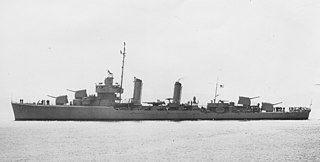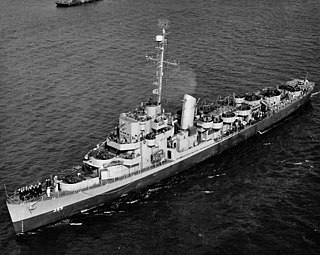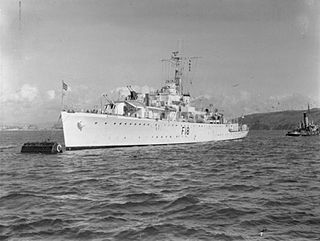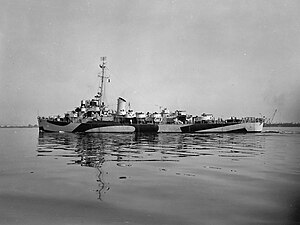
USS Cannon (DE-99) was a destroyer escort launched on 25 May 1943 by the Dravo Corporation in Wilmington, Delaware and was sponsored by Mrs. E. H. Cannon. Cannon was commissioned on 26 September 1943 and reported to the United States Atlantic Fleet. The ship was named in honor of George H. Cannon, a Medal of Honor recipient.

USS Ingraham (DD-694) was a United States Navy Allen M. Sumner-class destroyer, the third ship in U.S. Navy history to be named for Duncan Ingraham. She was in commission from 1944 to 1971. Following her US service, she was sold to the Hellenic Navy and renamed Miaoulis. The ship was sunk as a target in 2001.

The third USS Decatur (DD-341) was a Clemson-class destroyer in the United States Navy following World War I. She was named for Stephen Decatur.

USS Carmick (DD-493/DMS-33), a Gleaves-class destroyer, was the only ship of the United States Navy to be named for Major Daniel Carmick (1772–1816), an officer in the United States Marine Corps who served during the Quasi-War with France and during the War of 1812.
USS Chickadee (AM-59) was an Auk-class minesweeper of the United States Navy, named after the Chickadee, a family of small passerine birds which appear in North America and Africa.

USS Darby (DE-218) was a Buckley-class destroyer escort in service with the United States Navy from 1943 to 1947 and from 1950 to 1968. She was sunk as a target in 1970.

USS Stockdale (DE–399) was an Edsall-class destroyer escort in service with the United States Navy from 1943 to 1947. She was sunk as a target in 1974.

USS Roche (DE-197) was a Cannon-class destroyer escort in service United States Navy from 1944 to 1945. She hit a mine in late September 1945. As it was uneconomical to repair her, she was scuttled in March 1946.

USS Huse (DE-145) was a U.S. Navy destroyer escort launched by Consolidated Steel Corp., Orange, Texas on 23 March 1943, during World War II. The ship was sponsored by Mrs. L. M. Humrichouse, daughter of Admiral Harry McLaren Pinckney Huse, whom the ship was named after and commissioned on 30 August 1943.

USS Samuel S. Miles (DE-183) was a Cannon-class destroyer escort built for the United States Navy during World War II. She served in the Pacific Ocean and provided escort service against submarine and air attack for Navy vessels and convoys. She returned home at war's end with eight battle stars to her credit.

USS Garfield Thomas (DE-193) was a Cannon-class destroyer escort built for the United States Navy during World War II. She served in the Atlantic Ocean and Pacific Ocean and provided escort service against submarine and air attack for Navy vessels and convoys.

USS Rinehart (DE-196) was a Cannon-class destroyer escort built for the United States Navy during World War II. She served in the Atlantic Ocean and Pacific Ocean and provided escort service against submarine and air attack for Navy vessels and convoys. The ship entered the reserves after the end of the war, and in 1950 was transferred to the Royal Netherlands Navy, where she served under the name De Bitter until 1967. She was sold for scrap in 1968.

USS Cates (DE-763) was a Cannon-class destroyer escort built for the United States Navy during World War II. She served in the Atlantic Ocean and the Pacific Ocean and provided escort service against submarine and air attack for Navy vessels and convoys.

USS Fessenden (DE-142/DER-142) was an Edsall-class destroyer escort built for the U.S. Navy during World War II. She served in the Atlantic Ocean and the Pacific Ocean and provided destroyer escort protection against submarine and air attack for Navy vessels and convoys.

USS Sellstrom (DE-255) was an Edsall-class destroyer escort built for the U.S. Navy during World War II. She served in the Atlantic Ocean, the Pacific Ocean and provided destroyer escort protection against submarine and air attack for Navy vessels and convoys.

USS Jack W. Wilke (DE-800) was a Buckley-class destroyer escort of the United States Navy.

HMS Mermaid was a Modified Black Swan-class sloop of the Royal Navy. Mermaid saw service as a convoy escort during the Second World War, taking part in the sinking of two German submarines while escorting Arctic convoys to and from the Soviet Union.

HMS Oakley was a Type II Hunt-class destroyer of the Royal Navy. She was originally to have been named Tickham, however she was renamed after her sister ship Oakley was transferred to Poland and was renamed ORP Kujawiak (L72). She entered service in May 1943, carrying out convoy escort, patrol and anti-shipping attacks for most of the rest of the Second World War. She was adopted by the Civil community of Leighton Buzzard in Bedforshire as part of Warship Week in 1942. In 1957, she was sold to the West German Navy, serving as a training ship for the German Naval Gunnery school until scrapped in 1972.

HMS Flamingo was a Black Swan-class sloop of the Royal Navy. She saw service as a convoy escort during the Second World War, seeing extensive service in the Mediterranean and Far East in 1945.

HMS Hart was a modified Black Swan-class sloop of the Royal Navy. She saw service as a convoy escort during the Second World War, seeing service in the Atlantic, Mediterranean and Far East in 1945. She also took part in the Korean War in 1950 and 1951.




















